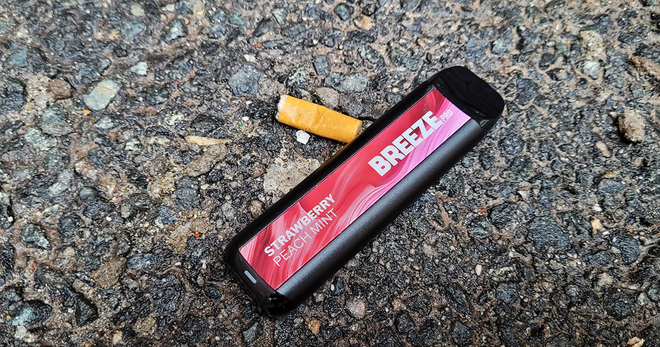Greater nicotine flux is associated with greater dependence among pod-based e-cigarette users, new research shows
Greater nicotine flux, or the rate that an e-cigarette emits nicotine, was associated with higher e-cigarette dependence among users of pod-based e-cigarettes like JUUL, according to recent Truth Initiative research published in Addictive Behaviors.
The pilot study examining the impact of e-cigarette device and liquid characteristics on nicotine dependence also found that younger age was significantly associated with e-cigarette dependence, underscoring concerns about e-cigarettes effectively delivering higher amounts of nicotine to young people and encouraging addiction. The findings speak to the need for regulations limiting overall nicotine delivery, rather than laws governing individual e-cigarette device components in an environment when local and federal legislation cannot keep up with quickly evolving e-cigarette technology.
E-cigarettes make nicotine delivery more efficient
Before JUUL was introduced in 2015, the most popular e-cigarette products contained nicotine strengths of between roughly 1% and 2.4%. When JUUL debuted, its pods contained 5% nicotine strength, with one JUUL pod containing 20 cigarettes worth of nicotine. The maker of JUUL claims its nicotine salt formulation increases the rate and amount of nicotine delivered into the blood, compared with other formulations. The company has claimed the product delivers nicotine up to 2.7 times faster than other e-cigarettes.
Nicotine concentration on its own does not determine nicotine exposure. The kind of e-cigarette device – disposable or pod-based – and other characteristics like an e-cigarette’s electrical power output can affect the rate that an e-cigarette emits nicotine – called nicotine flux. Researchers asked 18-65-year-old former or current e-cigarette users about these factors and gauged their dependence on e-cigarettes by asking them to what extent they agreed or disagreed with statements like “I find myself searching for my e-cigarette without thinking about it,” “I drop everything to go out and get e-cigarettes or e-juice,” and “I vape more before going into a situation where vaping is not allowed.”
Among pod-based e-cigarette users, those who were younger (between the ages 21-34) as well as those who had used e-cigarettes in the past month showed higher dependence on e-cigarettes compared to older respondents and those who hadn’t used e-cigarettes recently, respectively. The research builds on previous findings that the highly efficient nicotine delivery of pod-based e-cigarettes is associated with nicotine dependence.
Higher nicotine levels in disposable devices
Greater rates of nicotine emission were not associated with higher e-cigarette dependence among users of disposable e-cigarettes like Puff Bar, Hyde, and Posh. The authors suggest that the way e-cigarette dependence was measured might not be suited to disposable e-cigarette users, resulting in this lack of association. For example, the items asking about searching for an e-cigarette without thinking about it, dropping everything to go out and get e-cigarettes or e-juice, vaping more before going into a situation where it is not allowed, and intolerable cravings may not apply to users of disposable e-cigarettes in the same way they might for users of other e-cigarette device types, the authors write.
However, higher nicotine levels in these disposable devices did appear to be a trend. Most disposable e-cigarette users (80.3%) had devices with high nicotine concentration levels, while the majority (61.2%) of pod-based e-cigarette users reported medium nicotine concentration levels. This is in line with findings that newer disposable e-cigarettes like Puff Bar, the most popular disposable e-cigarette device with young people in 2021, contain up to 7% nicotine, even greater than JUUL.
More than half (55.9%) of survey respondents who exclusively used disposable e-cigarettes were 18-20 years old, raising concerns about exposure to high nicotine levels in young adults, especially as disposable e-cigarettes skyrocket in popularity. In 2020, use of disposable e-cigarettes increased 1,000% among high school students over the previous year after federal restrictions banned the sale of other types of flavored e-cigarettes. And in 2021, more than half (55.8%) of high school students who use e-cigarettes used disposable e-cigarettes, according to data from the Centers for Disease Control.
Need for strong regulation that limits nicotine exposure
Findings from the study suggest that because nicotine flux demonstrates a significant effect on e-cigarette dependence, “regulators should measure nicotine flux as an important variable in associations between e-cigarette device and liquid characteristics and nicotine dependence.”
The authors also suggest that regulating just one factor among many affecting levels of nicotine delivery would not solve the problem: “Given the great variability in e-cigarette characteristics influencing nicotine delivery, regulations based upon a single factor (e.g., liquid nicotine concentration) are unlikely to control nicotine exposure, and thus nicotine dependence,” the authors write.
The Food and Drug Administration has yet to review most products that make up over 75% the e-cigarette market—like JUUL—despite a court order requiring it to do so. As part of recommendations for the agency’s review process, Truth Initiative has called on the FDA to limit nicotine in e-cigarettes by capping nicotine strength and delivery as is done in the in other countries. These restrictions are critical for helping reduce the addictiveness of these products.
More in harmful effects of tobacco
Want support quitting? Join EX Program
By clicking JOIN, you agree to the Terms, Text Message Terms and Privacy Policy.
Msg&Data rates may apply; msgs are automated.


